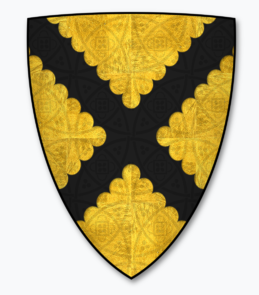Belchamp Walter - The Botetourt Years
13?? - 1391
The presence of the elaborate arch to what is thought to be a chantry Chapel dedicated to the Botetourt family would suggest that the family is one that had a significant place in the village's history.
There are conflicting records relating to the Botetourt family and the church guide wrongly attributes the chantry to Sir John de Botetourt, First Baron Botetourt. There is much information to be found on this first John de Botetourt and it would appear that he would have been far too busy to have been in Belchamp Walter when he was alive. The first John Botetourt is thought to have lived from 1265 until 1324.
My current thought is that the chantry was built for Sir John de Botetourt, 2nd Lord Botetourt. This Sir john was the only son of Thomas de Botetourt who is thought to have lived in Mary Hall at around the year 1300. Thomas' son was a knight who fought along-side Sir Robert Swynbourne in the Hundred Years War and at the Battle of Crecy (26 August 1346).
Sir Robert Swynbourne was married to Joyce Botetourt, daughter of the 2nd Lord. The manor of Belchamp Walter then passed to the Swynbourne family from 1391-1431.
The First Lord Botetourt
Village history has the chantry chapel dedicated to the 1st Lord de Botetourt. While this Sir John definitely had connecctions to the village of Belchamp Walter during his lifetime (1265-1324), he was not likely to have spent any time there. He was far too busy with Edward I's exploits in Scotland
The Advowsen
The dates are taken from Newcourt's Repertorium. According to Newcourt the Advowsen for the manor and church was held by Botetourt prior to 1392.
Belchamp Walter prior to the Botetourt Years
While the connection of the Botetourt family started at the end of the 13th century the marriages of other local families may have created a confusion on who actually was the "holder" of the region at this time.
The best that I can find that relates to this time period has been deduced from Thomas Wright's History and Topography of Essex (1831/36). Wright is not easy to follow and tends to wright descriptions with multiple family names in a single sentance. I have attempted to transcribe the section in his book for the Hundred of Hinkford
Before the Botetourt involvement in the history of Belchamp Walter much land was "traded" between barons and nobles of the post conquest history of the country was made. The Honours of Clare and the fortunes of the de Veres has a lot to do with this history. John Botetourt, Edward I and Edward II, the Despensers, the de Beachamps and Fitz Othos all had an influence on the region. Many battles were fought to establish who "held" what. The aftermath of the defeat of the English at Bannockburn led to the redistribution of territory after the death of Gilbert de Clare, 7th Earl of Gloucester.
Joan of Acre was the first wife of Gilbert and she "enjoyed" his lands after his death.
Elizabeth de Clare was the youngest daughter of Gilbert and she John de Burgh and thence known as Elizabeth de Burgh. Elizabeth de Burgh owned most of Sudbury, Suffolk.
Eleanor de Clare (1292–1337) married (1st) Hugh Despenser the Younger, a favourite of her uncle Edward II. Hugh was executed in 1326, and Eleanor married (2nd) William la Zouche Mortimer.
1st Lord BotetourtI start my Botetourt years at Belchamp Walter at around the start of the 14th century. While the Sir John that is referenced in the church guide was born in 1264, the 13th century, he was far to busy in Scotland on Edward I's conquest of Scotland and then involved with the barons opposed to Edward II (Lords Ordainers) and was probably involved with the Gascon campaign of 1294 to 1303.
2nd Lord Botetourt and Joyce de Botetourt
Joyce de Botetourt (Zouche) was married to Sir John de Botetourt, 2nd Lord.
The Monarchy
The 14th Century has the following monarchs:
- Edward II 1307-1327
- Edward III 1327-1377
- and finally Richard II 1377-1399
Edward I died in 1307 and the connection to the 1st Lord Botetourt saw his exploits in Scotland, Gascony and his relationship to the Barons that would form an opposition to his son Edward II.
Edward I, as Prince, aquired the land of the de Beauchamps as the result of the Battle of Evesham.
The 1st Lord Botetourt in his later years was caught-up in the events that led to the deposition of Edward II. He fought in the Battle Boroughbridge on the side of Thomas Lancaster and Boroughbridge saw the end of the Depenser War. The interactions between Botetourt and Hugh Depenser the Younger seem to have involved the transfer or re-assignment of many manors.
Thomas and Joyce
If Thomas Botetourt owned or lived in Mary Hall Belchamp Walter and was the person responsible for the construction of the chantry chapel, then this gets very confusing.

